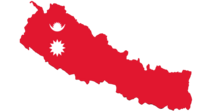|
Dharanidhar Koirala
Dharanidhar Koirala (Nepali: धरणीधर कोइराला;1893–1980; also known as Dharanidhar Sharma Koirala) was a Nepali poet sometimes known as Pandit-ji.[2] BiographyDharanidhar Koirala was born in 1893 in what is now Sindhuli District into a Hindu Brahmin family.[3] He studied Sanskrit and English from Banaras, British India.[4] In Banaras, he saw Indian people promoting their mother tongue which inspired him to "think about Nepal and the Nepali language".[4] In 1918, he was exiled to India, where Koirala, Surya Bikram Gyawali, and Parasmani Pradhan became known as "SuDhaPa".[5] In 1924, Koirala with Surya Bikram Gyawali, Parasmani Pradhan, Hari Prasad Pradhan, and others established the Nepali Sahitya Sammelan in Darjeeling, British India.[6] The establishment of this organisation was seen as a major event in Nepali literature's history.[7] Koirala was a key advisor to Sir Ralph Lilley Turner who published Comparative and Etymological Dictionary of the Nepali Language in 1931.[2] He wrote poems about social reforms.[8][9] In 1978, Koirala was awarded a Doctor of Letters degree by Tribhuvan University.[10] He was also awarded Tribhuvan Pragya Award by Nepal Academy for his contributions to Nepali literature.[11] Koirala died in 1980.[4] In 1994, the Government of Nepal issued postage stamps featuring Koirala.[12] Works
References
Citations
|
||||||||||
Portal di Ensiklopedia Dunia

